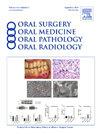Does open-mouth temporomandibular joint computed tomographic imaging provide added value in the diagnosis of temporomandibular disorders?
IF 2
3区 医学
Q2 DENTISTRY, ORAL SURGERY & MEDICINE
Oral Surgery Oral Medicine Oral Pathology Oral Radiology
Pub Date : 2025-02-04
DOI:10.1016/j.oooo.2024.11.031
引用次数: 0
Abstract
Objective
Temporomandibular disorders (TMDs) include a group of conditions that involve the temporomandibular joints (TMJs), masticatory muscles, and all associated tissues. Computed tomography (CT) is the modality of choice to evaluate the TMJ for osseous degenerative changes. Considering that limitation of mouth opening is a frequent manifestation of many TMDs, protocols for TMJ imaging traditionally have included views in the open and closed positions to assess condylar movement relative to the crest of the articular eminence. In this study, we examined the added value of the open scan to clinical decision making.
Study Design
This retrospective study evaluated records of patients who presented with TMD and were evaluated with cone beam computed tomography (CBCT) imaging. The pilot phase includes 22 subjects. The range of motion from the clinical examination was recorded and extent of condylar translation was assessed on the CBCT scans. Condylar movement was scored as “limited” when translation stopped before the crest of the articular eminence and “positive” when the condyle reached or went beyond the crest of the articular eminence.
Results
There was concordance in assessment between clinical mouth opening and radiographic condylar translation in 7 of 22 subjects (32%). When radiographic translation was scored as positive (n = 5), bilaterally, clinical opening was more than 40 mm. Likewise, when limitation of condyle translation was unilateral (n = 4), mouth opening was more than 40 mm. In contrast, in 13 subjects with radiographic limitation of condyle translation, mouth opening was more than 40 mm.
Conclusion
Our results suggest that radiographic translation is not a good surrogate for mouth opening noted clinically. Therefore, we do not support the use of open-mouth CBCT scans to assess condylar translation. The elimination of the open scan will decrease the radiation dose to the patient and free up personnel time. Next, we are examining whether the open-mouth scan provides any value to patient management.
求助全文
约1分钟内获得全文
求助全文
来源期刊

Oral Surgery Oral Medicine Oral Pathology Oral Radiology
DENTISTRY, ORAL SURGERY & MEDICINE-
CiteScore
3.80
自引率
6.90%
发文量
1217
审稿时长
2-4 weeks
期刊介绍:
Oral Surgery, Oral Medicine, Oral Pathology and Oral Radiology is required reading for anyone in the fields of oral surgery, oral medicine, oral pathology, oral radiology or advanced general practice dentistry. It is the only major dental journal that provides a practical and complete overview of the medical and surgical techniques of dental practice in four areas. Topics covered include such current issues as dental implants, treatment of HIV-infected patients, and evaluation and treatment of TMJ disorders. The official publication for nine societies, the Journal is recommended for initial purchase in the Brandon Hill study, Selected List of Books and Journals for the Small Medical Library.
 求助内容:
求助内容: 应助结果提醒方式:
应助结果提醒方式:


